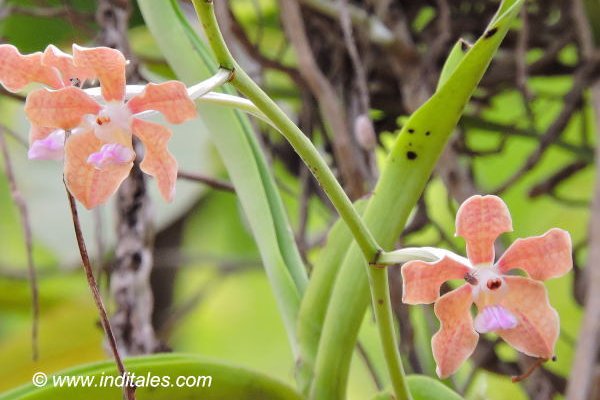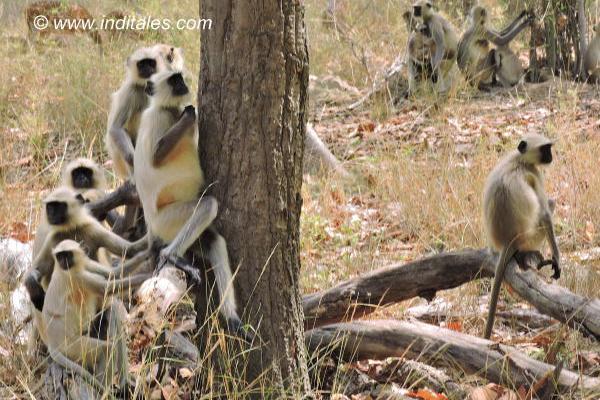Bandhavgarh National Park is best known for tiger sightings. Being a small national park with a fair number of tigers, tiger sightings here are almost guaranteed. In fact, we were told that you have to be lacking in luck to not see the tiger here. As luck would have it, the Tigers decided to give us a miss for all three safaris that we took in the Magadi and Tala Zone. Some fellow travelers did see the tiger.
Confirming that it was indeed a matter of destiny for those who missed. What happens when you miss the most coveted catch of the jungle? You start observing the rest of the jungle and its ecosystem. This is exactly what happened to us. We saw the Bandhavgarh national park in all its diversity.

Bandhavgarh National Park Beyond Tigers

Trees
Sal trees with their fresh green leaves dominated the jungles of Bandhavgarh National Park. Followed by bunches of Bamboo trees. Sandy earth from which these trees come out, reminds me of the times when this place might have been a part of an ocean. That left its mark on this land with its sand. An intriguing part of these jungles is the Lyna Vine – which is a vine that grows on Sal trees by wrapping itself around the tree. The irony is that it is a parasitic vine and eats the very tree that it grows on. Once the tree that it grows on dies, it obviously dies itself. At a philosophical level, is this not how many people behave in life? They cut the very trees that sustain them, only to realize that they have no identity without this tree.

Our guide showed us many medicinal plants in the jungle that are used by the local tribal populations. Who has been residing in these jungles since time immemorial? For example, Anti-Malaria plants like Chloroxylon Swietania, locally known as Bhira.

The Saja tree is an ash-grey colored tree with a skin pattern resembling that of crocodile skin. This is a tree that is worshiped by the locals as a representative of Shiva for this tree also resembles his ash-smeared skin. They never cut this tree for any purpose and would bow down to it as and when they pass through it. There were Jamun trees at places leaving the dirty paths pink and purple with their juice.
Birds at Bandhavgarh

Birds flying in their natural habitat became the favorite catch for my camera. Pitta and Indian Roller flew around flaunting their colors as they flew. Indian Pitta looks lovely in its bright yet somber colors when it is sitting. But is a riot of colors when it flies – especially on its red back. No wonder it is called Nauranga in Hindi or the Nine-colored. Indian Roller reveals its bright blue colors beneath its wings as it flies while the blue merges with its grey top while it is sitting on the branches.

Woodpeckers and Orioles gave me a tough time with my camera as if saying – enjoy us. And let others come to us and meet us rather than see us through your camera. Point taken.

Variety of Birds
Birds of prey like Oriental Honey Buzzard, and Crested Serpent Eagle sat confidently on the tree branches oblivious to the tourist pointing their long lenses towards them. They were either flying high in search of prey or sitting quietly on the tree branches. I assume after having their fill of the day. Painted Storks sat in the distance, mostly in the meadows, with their eyes scanning the grasslands for a potential meal. Jungle Babblers camouflaged their dusty color but would get noticed with their constant movements. And for a fact, they always occupied the branches in bunches. Black and White Magpie played hide and seek with me and my camera and beat me hands down for I could not catch it.
Spotted doves had a quiet presence in these jungles. Black Ibis, Drongos, Cormorants, and Lap wigs were also seen mostly in flight. Peacocks ready to shed their feathers ran around adding their brightness to the jungle.

Wild Animals
A bear busy looking for its food entertained us for quite a few minutes. He was digging a small termite hill ferociously looking for termites to eat. It turned around a few times to dig the pit from various sides. While we clicked its video and pictures, it showed us its face for a split second maybe. Wild boars made guest appearances here and there. Spotted deer dominated with their numbers – always found in big groups. As if being in the group would save them from the animals who feed on them. Sambar deer which is always referred to as the most stupid animal can be found in pairs moving around – with alert ears.
Monkeys – common monkeys, as well as the Hanuman Langurs, were found with their little ones clinging onto them or some of them hugging the trees. At one place we found a huge bunch of them drinking water from a pond, and then admiring their own reflection.
Video of Sloth Bear at Bandhavgarh National Park
Watch this video of the Sloth Bear I managed to capture at the national park.
Read about our Night Safari at Satpura National Park when we sighted a pair of sloth bears.
Butterflies & Insects

One particular tree that I choose to call Buzzing Tree with small white flowers was home to many butterflies and insects. We spent quite some time standing under this tree on two different safaris. And were amazed to see two different sets of insects and butterflies in the morning and evening.
3 Zones of Bandhavgarh National Park

The National Park is divided into 3 main tourist zones – Khatauli, Magadi & Tala. Tala is the premium zone followed by Magadi. Both these zones are located on either side of a giant rock hill also called the Bandhavgarh Fort. Even when they are adjacent, you can easily see the difference between the two zones.

Tala is a much denser zone with thick trees, and lovely landscapes compared to the Magadi zone. I did 2 safaris in Magadi and one in Tala. I would definitely choose Tala over Magadi, although I was told the tiger sightings are much more in Magadi.
Giant Bread for the Elephants

A forest department elephant with a Mahout roams around looking for tigers and directs the jeep in the most probable directions to see them. Now near a well where a big snake was resting coiled inside the well. We found the feeding place of this elephant. Giant chapatis – each made from a kilo of flour were being cooked. They looked too small for the elephant. But we were told that each day elephant is given two such chapatis for breakfast and 8 for a later meal. And then he is free to graze in the jungle.

Here and there we found orchids sprouting from the tree trunks. At one place we found a man from the Baiga tribe picking up the fallen stuff in the jungle. I assume as they did always, taking what the jungle offers gracefully.

It seems not finding the tiger turned out to be a blessing in disguise. We observed the jungle in all its diversity – of course, limited to birds and animals who decided to make an appearance on our path.
Recommend you to read the following blog posts on the National Parks of India on my Travel Blog.
Meeting Munna – Rock Star Tiger at Kanha
History, Life inside Bandhavgarh














I have fond memories of my visit to Bandhavgarh and even if you didn’t see the Tiger I am sure they saw you!!! Lucky you got to see the sloth bear I didn’t!!! Of course we did see the tigers and three cubs too. Also went for the evening joy ride on the elephant, lovely ride even through thick forest, not just on the roads.
Yes, we were told that Sloth bear sighting is quite rare. I missed the elephant ride, I think they happen lot less now with new restrictions.
Indeed a jungle is so much more than Tiger! Wonderful pictures Anuradha…I envy your camera 🙂
Ye Lo, a photographer envying my humble little camera 🙂 Nikon would be very happy though.
Good to see a story outside tigers. And by the way, sloth beer sounds very exciting! 🙂
:-), Did you not see the Sloth Bear. Wait till I post the video too…
I did… But sloth beer… look it up on the page. 🙂
:-), the bears must have been drunk on beers for they did not attack us despite our putting flash lights on them…. ( thanks for pointing out the typo – have rectified it)
Wonderful experience. It is mostly when we don’t spot the main attraction that we enjoy the forest and the other animals better. Had a similar experience in Bandhavgarh. Din’t sight any tigers but loved the forest.
That makes it two of us Niranjan.
Well observation, well written. Thanks for sharing.
Thank you Tushar.
We Indians have to learn how to travel..nice post.
Thank you Sunil. Why do you say ‘We Indians’? In my opinion, we in India always had the tradition of travelling, it is recommended right in Rig Veda. Yes, it was never such a big commercial product, as it is today.
Thanks for sharing this experience and your lovely pictures for those of us who can only dream of such travels!
I promise if it is in your dreams, it would a reality soon enough Chitra.
Very nicely written
Thank you Ranjani 🙂
Nice Blog. I Read Three Episodes. Enjoyed and also loved the nice Pictures, Anuradha.
Thanks Anil.
So beautiful. Bandhavgarh has been on our list forever now… must make a visit soon. And beautiful images too…
Happy that you are inspired to pack your bags. Do share your thoughts once you are back.
Sitting in comforts of home… Had a tour of wildlife sanctuary !!! Well scripted… Informative too
Welcome to IndiTales Kaliappan. Happy that you enjoyed the travel blog on Bandhavgarh.